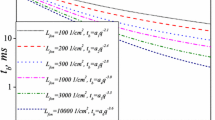Abstract
An experiment on thermally driven 4He superflow (Chagovets and Skrbek in Phys. Rev. Lett. 100:215302, 2008; J. Low Temp. Phys. 153:162, 2008) yielded very different steady state turbulence properties from a nominally identical recent realisation where the helium fountain drive was replaced by bellows. Here we argue that differences are most likely not due to fundamental reasons, but to incorrect velocity calculation in the fountain drive version. We show by a combination of direct velocity measurements and indirect analysis that the real velocity is significantly lower than predicted, and one main reason for this is unaccounted heat spent to enhance helium evaporation. The velocity correction brings the two experiments in reasonable agreement. We also suggest that the transition to a new state of superfluid turbulence claimed in Refs. (Chagovets and Skrbek in Phys. Rev. Lett. 100:215302, 2008; J. Low Temp. Phys. 153:162, 2008) may be a spurious effect of an observed nonlinearity occurring between fountain heat current and superflow velocity.







Similar content being viewed by others
Notes
This is justified by the fact that the pressure of the vapour is maintained constant before and after the heater is switched on by regulating the rate of pumping on the helium bath.
This in general is not true, as some atoms bounce back into the gas phase for some incidence angle. At any rate, even if the rate of condensation is overestimated by a few times, the qualitative conclusion of this argument would not change.
This pair of old superleaks have been routinely used in the bellows-driven flow experiments, producing highly reproducible results over about 2 years of constant activity, except in the last run, when the superleaks have been moved from the velocity measurement setup E3 to the bellows setup and we have observed that flows of sufficiently high velocity were causing overheating of the helium in the flow channel, perhaps due to onset of dissipative flow due to pore cross-section reduction. Additionally, we have also noticed that the newly fabricated superleaks readily absorb ethanol through the surface, whilst the older pair does not.
A more precise comparison would be possible only knowing how ΔT (and hence \(\dot{Q}_{e}\)) varies with \(\dot{Q}\). Experimentally we only know that ΔT is of order 1 mK in both E2 and E3, for all \(\dot{Q}\), so this check cannot really go beyond a qualitative order of magnitude estimation.
The nonzero intercept \(\dot{Q}_{0} \approx 40\) mW is most probably due to the excess heat spent for evaporation before the flow begins. The departure from linearity occurring at higher heat currents may be due to changes in the manner in which the heat is channeled to different sinks as \(\dot{Q}\) is increased, the details of which are not understood and are not crucial for our discussion.
Consistently with this, an Erratum statement has been published by the original authors in Physical Review Letters.
References
T.V. Chagovets, L. Skrbek, Phys. Rev. Lett. 100, 215302 (2008)
T.V. Chagovets, L. Skrbek, J. Low Temp. Phys. 153, 162 (2008)
S. Babuin, M. Stammeier, E. Varga, M. Rotter, L. Skrbek, Phys. Rev. B 86, 134515 (2012)
R.A. Ashton, L.B. Opatowsky, J.T. Tough, Phys. Rev. Lett. 46, 658 (1981)
W.F. Vinen, Proc. R. Soc. 240, 114 (1957)
W.F. Vinen, Proc. R. Soc. 242, 493 (1957)
J.T. Tough, Superfluid turbulence, in Progress in Low Temperature Physics, vol. VIII (North-Holland, Amsterdam, 1982)
K.P. Martin, J.T. Tough, Phys. Rev. B 27, 2788 (1983)
R.J. Donnelly, C.F. Barenghi, J. Phys. Chem. Ref. Data 27, 1217 (1998)
Acknowledgements
We are especially thankful to T. V. Chagovets, co-author of Refs. [1, 2], for many useful discussions and extensive support in accessing original experimental data. We thank W. F. Vinen for his valuable advice and help during his visit at our Laboratory, especially with the calculation presented in Sect. 2.1. Additionally, we thank L. Doležal, M. La Mantia, M. Rotter, D. Schmoranzer and B. Vejr for technical help and useful discussions. We acknowledge support from grant GAČR 202 08/0276.
Author information
Authors and Affiliations
Corresponding author
Rights and permissions
About this article
Cite this article
Babuin, S., Varga, E., Stammeier, M. et al. Mechanically Versus Thermally Generated Quantum Turbulence of 4He Superflow. J Low Temp Phys 171, 551–562 (2013). https://doi.org/10.1007/s10909-012-0835-9
Received:
Accepted:
Published:
Issue Date:
DOI: https://doi.org/10.1007/s10909-012-0835-9




